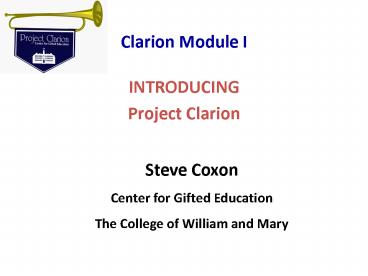Clarion Module I - PowerPoint PPT Presentation
1 / 13
Title:
Clarion Module I
Description:
... Center for Gifted Education, College of William and Mary Instrumentation: Baseline Identification Naglieri Nonverbal Ability Test (NNAT); ... – PowerPoint PPT presentation
Number of Views:39
Avg rating:3.0/5.0
Title: Clarion Module I
1
Clarion Module I
- INTRODUCING
- Project Clarion
Steve Coxon Center for Gifted Education The
College of William and Mary
2
Think Like a Scientist Inquiry-Based Science
Units for K-3 Learners
- Joyce VanTassel-Baska, Ed.D.
- Co-Principal Investigator
- Bruce A. Bracken, Ph.D.
- Co-Principal Investigator
- Lori C. Bland, Ph.D.
- Project Director
? 2009 Javits Project Clarion, Center for Gifted
Education, College of William and Mary
3
My goal is to involve you in
- Using the Frayer model of vocabulary to define a
scientist - Understanding the macro-concepts systems and
change, how they can help students
meta-cognitively, and their interdisciplinarity - Using inquiry with the Wheel of Scientific
Investigation and Reasoning to conduct an
experiment - Your units content and concept-mapping and
- Pre-, on-going, and post-assessments.
4
Project Clarion Objectives
- To use instrumentation sensitive to low
socio-economic learners for identification and
assessment of learning - To implement, refine, and extend research-based
concept curriculum in grades K-3 in three
different school districts - To develop and implement professional training
models for teachers, administrators, and broader
school communities - To conduct research on short term and
longitudinal student learning gains as well as
the mechanisms that promote the
institutionalization of innovation through
scaling up
? 2009 Javits Project Clarion, Center for Gifted
Education, College of William and Mary
5
Clarion Curriculum Goals
- To develop selected basic concepts related to
understanding the world of science - To develop selected macro-concepts that unify
understanding basic concepts in science (i.e.,
systems and change) - To develop knowledge of selected content topics
in science - To develop interrelated science process skills
- To develop critical thinking skills
- To develop creative thinking
- To develop curiosity and interest in the world of
science
? 2009 Javits Project Clarion, Center for Gifted
Education, College of William and Mary
6
Project Clarion Alignment to Standards
- National Science Education Standards
- Benchmarks for Science Literacy
- Virginia Standards of Learning
- Unit-specific knowledge
- National Association of Early Childhood Education
7
Unit Titles by Grade Level
Grade Levels Life Science Earth Science Physical Science
K - 1st Survive and Thrive How the Sun Makes Our Day Water Works
1st - 2nd Budding Botanists
2nd The Weather Reporter
2nd 3rd What's The Matter?
3rd Dig It! Invitation to Invent
Published by Prufrock Press ? 2009 Javits
Project Clarion, Center for Gifted Education,
College of William and Mary
8
PROJECT CLARIONLets stop for a moment and take
a look at
- Table of contents in three sections
- I Unit overview (Concept map, Overarching
concept, Scientific investigation, Curriculum
Framework, Alignment to standards, etc.) - II Lesson plans
- III Appendices (Safety, Four teaching models
Concept development, Wheel of Scientific
investigation, Concept mapping, Frayer vocabulary
development), Concept paper, Assessment Package)
9
Research Design
- Quasi-Experimental
- Random Assignment
- Treatment Fidelity
- Classroom observations
- Teacher self report of lesson logs and feedback
- Comparison Curriculum
- Teacher created
- Purchased science curricula
- (e.g., Harcourt Brace)
- ? 2009 Javits Project Clarion, Center for Gifted
Education, College of William and Mary
10
Sample
- Three Districts
- urban
- exurban
- rural
- More than 3400 students
- 6 Title I Schools
- 38 experimental classrooms
- 36 comparison classrooms
- Ethnicity
- Caucasian 29.9
- Hispanic 26.8
- Asian 18.6
- African American 11.7
- Other 2
- Native American .6
- Gender
- Male 49.2
- Female 49.4
? 2009 Javits Project Clarion, Center for Gifted
Education, College of William and Mary
11
Instrumentation Baseline Identification
- Naglieri Nonverbal Ability Test (NNAT)
Reliability between .81-.89 - Percent of Experimental and Comparison Students
in Sample by Ability Category
? 2009 Javits Project Clarion, Center for Gifted
Education, College of William and Mary
12
Instrumentation Assessment of Learning
- Performance-Based Assessments
- Concept, Scientific Investigation, Content
- Content validity relevance, clarity,
appropriateness - Rubric and Protocol Adapted from Fowler
- Alternate Forms Reliability .76
- Inter-rater Reliability .90-.95
- Test of Critical Thinking (TCT)
- Administered to 3rd grade (post only)
- Reliability .89
? 2009 Javits Project Clarion, Center for Gifted
Education, College of William and Mary
13
Project Clarion works
- Across two years, the performance-based
assessment results showed significant and
educationally important gains for experimental
students in - Macro-concepts
- Scientific investigation
- Content mastery
- Across two years, the Test of Critical Thinking
showed significant and educationally important
effects for the third grade students in the
experimental group.
? 2009 Javits Project Clarion, Center for Gifted
Education, College of William and Mary

